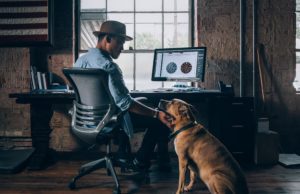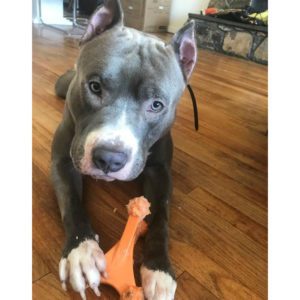Why does my dog follow me around from the moment I walk in the door from work? We recently had this question to us. We like to invite our ISCDT students to reflect on the question before reading our response. Find out if your answer matches ours. Here is our response to this dog owner:
There are several reasons your dog may act like a velcro dog when you return home from work every day. We have provide five possibilities:
Routine. If you feed your dog, play in the yard or bring your dog for a walk the moment you come home, then you have created a routine. Your dog is demanding your attention so these routines can be carried out.
How you can work on this issue: Any change in a dog’s routine should be gradual. If you prefer a time to unwind when you get home from work, settle the dog in a quiet space and provide canine enrichment for your dog. This can be a stuffed Kong, a special bone, a puzzle or a treat releasing ball. Something that will hold the dog’s attention for around 10 or 15 minutes. You can gradually add additional time between your arrival home and meeting your dog’s exercise needs, provided you move slow. Remember, these activities should not replace your normal routine with your dog. It just alters the routine so your dog learns that walks and playtime do not take place the moment you walk through the door.
Boredom: If nothing exciting happens for your dog on a daily basis, following you around may be the biggest joy of the day.
How you can work on this issue: Don’t leave “fun” until the end of the day. Hire a dog walker for a mid-day walk or enroll your dog in doggie daycare. Start your day a little earlier each morning and use the extra time to walk your dog, engage her in a game of hide and seek, play frisbee or enjoy flirt pole play with your dog. You can also leave interactive games around the house for your dog to enjoy while you are away from home. You will never go wrong by hosting a training session with your dog before you head out for the day. During this training session, work on a new command, teach your dog to heel or introduce your dog to a new trick. Mental stimulation is not only enjoyable, it is exhausting for a dog.
Reinforcing behavior: If you cater to your dog every time he requests your attention, your dog has learned that being pushy gets things done.
How you can work on this issue: You’ll have to ignore the barking, pawing, whining and any other bossy behavior from your dog. Your dog likely learned that this behavior gets them what they want. While it is not easy to ignore a barking dog, you need to reteach them that this behavior will not lead to what they want. Teaching your dog that bossy behavior gets nothing, but a calm, relaxed dog makes fun things happen, will change the behavior. After they have quieted down, walked away and and are relaxing, you can move on to the next step in the process. Teach your dogs that they should do something “for” you in order to get something “from” you. This is known as the Premack Principal. You can learn more about this by watching a quick video on our Youtube channel. https://www.youtube.com/watch?v=WqICmAlWokU
Separation anxiety: Your dog may feel stressed in your absence. Once you return, they cannot relax anytime you move for fear you will leave again.
How can you work on this issue: Hire a dog trainer or dog behaviorist who specializes in separation anxiety.
Lack ability to self sooth or entertain: Dogs with owners who play with them from morning until evening never learn how to entertain themselves. In their mind, the human brings all fun. Without the human, there is no fun. Some breeds are dependent on their owners. They rely on their owners for guidance because the breed was bred to provide a service to their human handler. This can include hounds, herding dogs and even some toy breeds.
What you can do to help: Teach your dog the place command. This command allows the dog to be with you, just not on top of you. The dog should remain in place as you move around the room and also while you sit and relax or eat. Keep a strict routine so your dog always knows what to expect and doesn’t spend the evening feeling anxious over your next move. Provide a fun activity for your dog to enjoy. Fun activities usually involve food, however, a dog bone, a ball or puzzle game may all keep your dog happy. Step out of the room (for just a minute or two) while your dog is enjoying the activity. When you return, call the dog over to you and tell them to leave the toy. Play for a few minutes and then give the item back to the dog before you leave the room again. Over several days, repeat these steps, adding more time away from your dog. Allow your dog to enjoy fun activities in your absence and then remove them when you return. If the activity is something your dog truly enjoys, they will not mind your absence because when you are away, fun things happen. Offer several different fun activities so the dog does not grow bored from them and begin looking for you again.
Is there something you’d like to ask our trainers? Email your question to info@iscdt.com. We’d be happy to answer your question.
Our 18 lesson, online program is a hands-on program where students are required to work with dogs. Skill and ability is determined through a series of videos submitted to the school. Students are also responsible for written homework assignments. We also offer a 2-week and 4-month in-person internship. To learn more about the courses we offer, visit ISCDT.com
Written by Katie McKnight





